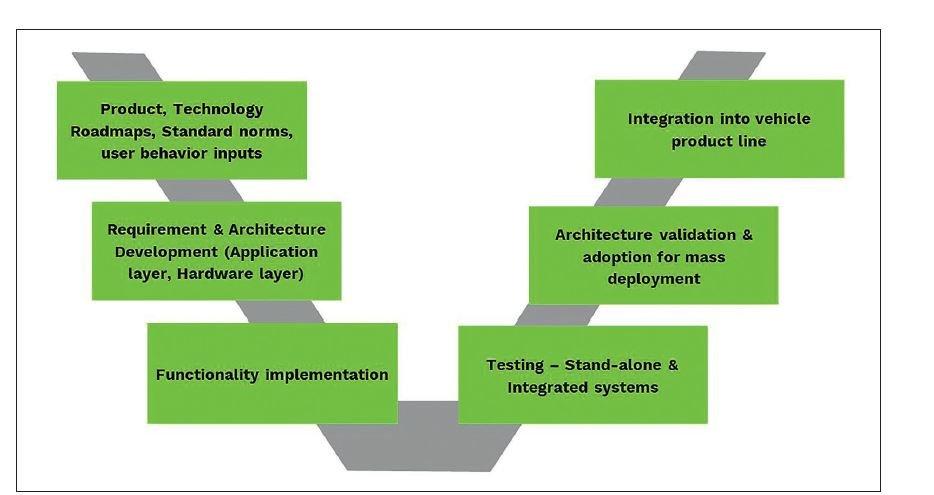
Electric Architecture: The backbone of an Electric Vehicle
Introduction
Adoption of Electric Vehicles (EVs) in private and commercial passenger vehicles is seen as a way for decreasing Greenhouse Gas (GHG) emission and to mitigate the climate change problems. Emission norms pushed the efficiency of the ICE engines to the higher level and manufacturers as well as regulators have taken significant initiatives to develop technologies to further curb the emission levels. The effective efficiency of an Internal Combustion Engine (ICE) due to various efforts has reached to ~35%, but still it bit less than the battery-operated electric motor, which is around 65%. Hence, among all these efforts and initiatives, the move towards electrification of transportation seems to be the most viable long-term solution. As a result, such developments & push by govt. forcing today’s vehicle manufacturers and suppliers to look for solutions and systems that promote the development of vehicle (electrical) architectures that allow the industry to transit from ICEs to the EV seamlessly.
The sub-systems in the existing vehicles such as air conditioning systems, electric steering, seat controls, anchor break, air bags, wipers, headlights, USB charging ports, etc. are already powered using low voltage electric supply. The low voltage electric supply to these sub-systems is obtained by using alternator (which is coupled to the engine) & from the suitable battery. New designs need to consider demand of existing architectures & challenges of future technology adoption. Thus, from the OEM point of view, vehicle architecture needs to be flexible enough so that it can adopt drivetrain electrification quickly using existing platforms. Modularity and reusability of existing architectures will make this transition smoother. Future platforms should have significant adoptions from today’s vehicle architecture.
While designing a Vehicle Architecture and respond to challenges thrown by the electrification of a vehicle, the key attributes needs to be considered are as follows:
- Power delivery path for components which use other than the electrical system (breaks, suspension control, steering, cooling);
- The electrical power demand of various sub-systems (e.g. infotainment systems, power windows, air-conditioning);
- Drive cycle-based torque/power requirements for all operating modes;
- Overall energy supply and management needs (including charging and regeneration capability utilization);
- Technical specifications for Products (e.g. opportunity of charging, quick charging, gradient, standards, drive cycle efficiency);
- Interaction with the external world (e.g. communication, bi-directional power transfer);
- Adoption of different energy sources (e.g. fuel cell, battery & its combination);
- Overall weight & volume of various components (battery, traction, air compressor);
- Cost, reliability & other key parameters related to technology maturity (e.g. use of silicon carbide-based system for dc-dc, inverter);
- Safety related parameters (e.g. use dual energy sources while powering aux systems such as battery management system, traction control system & vehicle safety system)
- Communication system layer (e.g. CAN for inter ECU communication, gateways for communications with the external world (charging infrastructure));
- Wiring harness and its placement (e.g. HV and LV system and its routing);
Electric Architecture (EA)
Traditionally, the electrical architecture in the ICE vehicle played a limited role i.e. control low voltage distribution, head lights, display, cooling, cranking systems etc. It did not control the flow of the power or energy in the vehicle, it only provided pulse discharge capacity for ICE engines. Due to the drastic reduction in the components used in the EV system, the role of VCU became more predominant as compared to ICE engine systems. Same is the case with the communication layer that connects each component to the VCU. Understanding, designing and developing the Vehicle Electronic Control Unit (VECU) & Electrical Architecture are crucial for the functioning of EV’s. The concept of Watt-hour/per km (Wh/km) or quick charging capability of battery packs were not part of design & trade off analysis. Thus, the EA needs to be reliable, efficient, fault tolerant, safety- as well as EMI/EMC compliant and it should allow the user to realize all operating modes of EVs (e.g. regular- sports- or utility mode).
EA plays an important role in handling and responding to the complexity of technology and vehicle features like for Electrification, ADAS, connected systems and for number of ECUs, which are interconnected by various vehicle network topologies with a distributed functionality. An architecture needs to test and validate various use cases related to normal, abnormal, safety, functionality and interoperability. The following key vehicle control strategies need to be considered, while designing the electrical architecture:
- Traction control (including Regeneration control);
- Body and chassis control;
- On board/Off board charger control;
- Battery Management system control;
- Auxiliary power system and its control;
- Communication Interface control (components internal to vehicle and external to vehicle);
- Controls required for standard & safety compliance;
Electrical Architecture & Design Approach:
Due to increasing complexity and issues arising through various advanced control features such as bi-directional power flow, super quick charging capabilities of batteries the workflow need to adopt to a “system of systems design approach”. A typical approach, that can be used while designing an EA for a vehicle architecture is shown in Figure 1.
EA to Drive Future EVs
An Electrical Architecture, due to its inherent nature, allows seamless integration of various futuristic technologies (e.g. Fuel Cell into BEV) in today’s vehicle. This requires special attention while designing & adopting an architecture which fulfils today’s need and allows the design to respond to tomorrow’s challenges. The future EA will enable vehicles to function faster and respond quicker to the infrastructure, which will be also more connected and smarter. An EA drives EVs as bi-directional power flow systems to interact with smart grid and a connected infrastructure. Today’s EV platforms are evolving towards multi sensor and automated driving technologies In this journey the EA will play a key role in collaborating, securing, self-learning, self-healing and connecting to each ECU and to the master VCU and the electric vehicle architecture will have to communicate, act and control faster to get the expected outcome.
We at KPIT have a capability to work on technologies from functional requirements or productions requirements till the final EV system architecture of the production development which covers wiring diagram, ECU control, power distribution, functionality and safety standards to achieve the electrification.
KPIT is a global technology company with software solutions that will help mobility leapfrog towards autonomous, clean, smart and connected future. With 7000+ Automobelievers across the globe, specializing in embedded software, AI & Digital solutions, KPIT enables customers accelerate implementation of next generation mobility technologies . With development centers in Europe, USA, Japan, China, Thailand and India – KPIT works with leaders in mobility and is present where the ecosystem is transforming.
KPIT Technologies GmbH
Frankfurter Ring 105b
80807 München
Telefon: +49 (89) 3229966-0
Telefax: +49 (89) 3229966-99
http://www.kpit.com
Head of Marketing Germany
Telefon: +49 (89) 3229966-140
Fax: +49 (89) 3229966-999
E-Mail: stefanie.koehler@kpit.com
![]()





